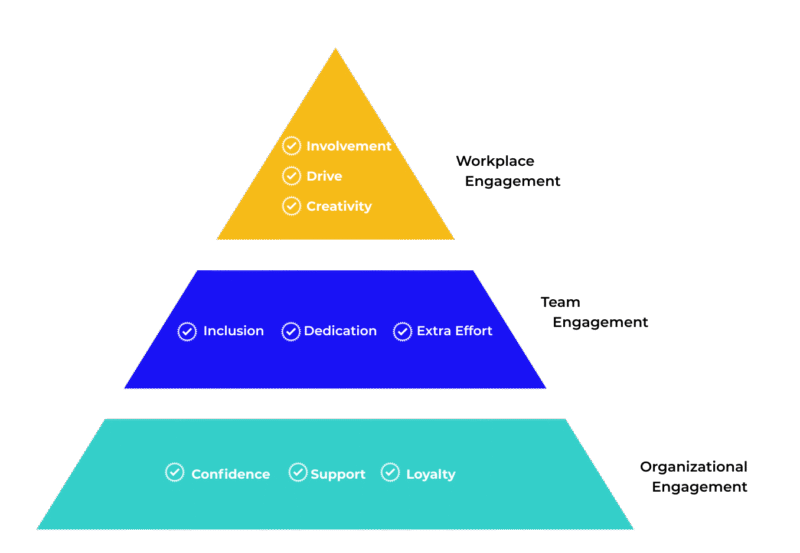A Complete Guide On How To Increase Employee Engagement
Employee engagement is one of the most important factors of business success. Organizations that have effectively engaged employees report increased profits and productivity. At the same time, businesses that fail to create an engaging work environment find themselves dealing with high employee turnover and many on-the-job mistakes. But what does it take to increase employee engagement? If you want to know the answer to this question, this guide is for you.
What's Inside This Guide:
- What Is Employee Engagement?
- Why Is Employee Engagement Important?
- Benefits Of Employee Engagement
- Whose Job Is Employee Engagement?
- What Are The Drivers Of Employee Engagement?
- The 3 Personas Of Employee Engagement
- How To Improve Employee Engagement: 16 Ways
- Choosing The Right Employee Engagement Software
- Engage Employees By Giving Them A Real Voice
What Is Employee Engagement?
Employee engagement is a key indicator of a healthy and thriving workplace. It shows that the organization makes its employees feel valued, involved, and connected with the company and their roles.
Employee Engagement Definition
Employee engagement can be defined as the emotional and mental connection employees feel toward their workplace, their team, and the work they do. Engaged employees are generally more productive, demonstrate greater levels of commitment, and contribute more positively to the company culture. They are not just working for a salary or the next promotion, but are genuinely interested in their work and motivated to contribute to successful business outcomes.
Engagement in the workplace is shaped by three key factors, each tied to a crucial question:
- Workplace engagement: Do I feel connected to the tasks I perform?
- Team engagement: How strong is my bond with my immediate colleagues?
- Organizational engagement: Do I feel a sense of belonging within the company?
By examining these aspects together, organizations can gain a clearer picture of overall employee engagement levels.

Why Is Employee Engagement Important?
Many in leadership roles believe that employees leave organizations due to a lack of advancement opportunities or better employment packages elsewhere. Even though there is truth in that, employees also quit due to engagement issues. First of all, employee engagement is essential for businesses that want to successfully reach their goals. Engaged employees are more efficient and go beyond what is expected of them. They're passionate about what they do and consider their work more than just a paycheck.
Still, some companies assume that employee engagement is directly linked to salary and compensation. But the truth is that connection and communication are also key drivers of engagement. As such, organizations can improve employee engagement outcomes by cultivating work relationships founded on clear, relevant communication. When you focus on communication, your employees feel supported, engaged, valued, and connected with their organization.
Companies that champion transparent communication practices can quickly build trust among employees, leading to better engagement and overall business success. Ultimately, establishing effective employee engagement strategies will help organizations create better work cultures, reduce staff turnover, boost productivity, and build better work and customer relationships. It all starts with engagement.
Benefits Of Employee Engagement
Successful companies acknowledge the fact that their workforce is their greatest asset. When your employees are properly engaged, they perform better and reach business goals faster. Here are some of the major benefits of employee engagement:
Higher Employee Retention And Employee Experience
Engaged employees have no reason to look for work opportunities elsewhere. They remain loyal to the same organization because they know they will be recognized for their contributions through personal growth opportunities and career development. They have a clear sense of purpose but understand when organizational change happens and why. These aspects are foundational for building trust between the workforce and the company, ensuring higher rates of talent retention, and for further refining employee engagement efforts.
Increased Employee Productivity
You are most likely to see high employee productivity when your employees are engaged at work. Productive employees typically focus on the right things at the right times, and their output returns the desired results. Obviously, engaged employees are more productive than disinterested or disengaged employees, which makes them more likely to take initiative, come up with innovative ideas, and go the extra mile to achieve their goals. You can always expect them to work diligently and pay undivided attention to their work.
Increased Customer Satisfaction
Your workforce becomes better at providing a positive customer experience to your client base when they are engaged. Engaged employees make continuous efforts to strengthen their knowledge and expertise in order to deliver better insights to their customers. They go above and beyond to offer quality service, make customers feel valued, and build stronger customer relationships. Finally, satisfied and engaged employees are also more likely to drive even higher returns by securing more sales through upselling and cross-selling.
Better Employee Health And Well-Being
A lot of organizations believe that a high-stress environment is the best way to motivate employees to perform their best. However, research from Harvard Business Review revealed that such a workplace environment actually reduces employee productivity over time. Moreover, studies have highlighted the role of employee engagement in lowering healthcare-related costs for employers. If your employees are engaged and work in a relaxed environment, the risk of workplace accidents is lowered, and since workplace stress can be the cause of serious health conditions, even emergency doctor visits become less frequent.
Greater Trust In Leadership
Managers have a tremendous impact on an employee's perception of the leadership and are often most involved in communicating upper leadership engagement initiatives from the top down. Therefore, leaders need to connect with their employees on a personal level if they want them to invest greater effort. By making time to engage with team members and get to know them, leaders establish mutual trust and ensure an effective working relationship between themselves and their employees, ultimately increasing company morale and job satisfaction.
Lower Absenteeism
Studies suggest that improving employee engagement can significantly reduce absenteeism, a common problem in the workplace with serious consequences. Absenteeism happens when employees are unsatisfied or indifferent to their work, often taking unexpected days off due to burnout, poor leadership, or attempts to interview for a new job. Contrarily, employees who love what they do are less likely to fall into absenteeism. Therefore, by focusing on improving motivation and engagement, employers can effectively combat this phenomenon and ensure satisfaction and long tenures among their teams.
Stronger Employer Brand
When your employees are engaged and feel satisfied with their work, they talk positively about you as an employer. This makes employee engagement essential. Encouraging positive brand advocacy is a great way to attract quality talent, drive higher revenues, and generate a more loyal customer base. So, along with a comprehensive employee engagement strategy, incentivize your employees with recognition and a well-rounded benefits package; these perks can encourage them to spread the word further.
Whose Job Is Employee Engagement?
Employee engagement begins at the top of a company's management ladder. The majority of high-engagement workplaces have executive leaders who don't just believe in employee engagement but also actively communicate and model it. They are the ones who cultivate the right environment for both managers and employees to adopt an engagement mindset.
On a team level, it is a manager's duty to engage their employees and actively support and advocate for them when needed. By consistently making sure that employees know what needs to be done and why, managers can also elucidate how workplace engagement connects to the overarching mission and success of the organization.
Unfortunately, just asking managers to work on employee engagement and coach their teams is not enough, as many of them have no clue how to make these conversations productive and meaningful, often slipping into micromanagement territory. As such, leaders must communicate the significance of employee engagement from the top down, building trust in the benefits of engagement and utilizing the right means for encouraging engagement-oriented behaviors.
Now, let's take a look at who is responsible for what when it comes to employee engagement.
The Role Of Leadership In Employee Engagement
Organizational leaders are influential advocates of high-engagement cultures, responsible for demonstrating the right behaviors, developing action plans, and supporting investments and stakeholder buy-in for employee engagement initiatives. They should communicate diligently about the perks and significance of employee engagement strategies.
The Role Of HR In Employee Engagement
HR professionals have the responsibility of directing and aligning leadership, management, and staff on employee engagement endeavors. At the core, HR professionals prioritize alignment and accountability of strategy actions, find the right implementation tools and processes, and support and develop managers and teams. Under their supervision, employee engagement strategies can be turned into actions that deliver maximum impact.
The Role Of Managers In Employee Engagement
Managers interact the most with their employees, so it is their responsibility to create a workplace environment where everyone can be truly engaged. A manager should build good relationships with every employee, take into account employee feedback and suggestions, and act based on an improvement-oriented mindset. They are also responsible for actualizing organizational priorities and goals, as well as encouraging employee growth and development through high-engagement activities.
The Role Of Employees In Employee Engagement
Employee engagement goes both ways. Although it's important for management to take the necessary actions to keep their employees happy and engaged, employees must also claim some accountability for their engagement. Everyone in the organization needs to make contributions toward employee engagement, and that includes all employees because they are the voices of the organization. Being the ones on the front line, they can provide honest feedback and offer invaluable insights on employee experience and engagement. To deliver on their commitment to the organization, they should also have a hand in brainstorming creative solutions that effectively address their concerns.
| Leaders |
|
| HR |
|
| Managers |
|
| Employees |
|
What Are The Drivers Of Employee Engagement?
Most companies make the mistake of treating employee engagement as a mandatory task and start stepping on the gas as the time for employee engagement surveys nears. But before you start designing your next survey, you must first comprehend the factors that impact employee engagement in general. There are five key drivers of employee engagement:
- Purpose
- Development
- Caring managers
- Ongoing conversations
- Focus on strengths

As you may realize, good paychecks and good vibes from colleagues are not always enough to keep employees engaged. While providing purpose and some meaning to their work can be useful in driving employee engagement, you also need to focus on the other key areas mentioned above.
Employees want positive connections with others in the organization, especially with a manager who can guide them to the next level. A caring manager can play a quintessential role in driving employee engagement. Additionally, candid, ongoing conversations about company goals and how employees can help the organization achieve them have the potential to further foster employee engagement.
Another important thing is for organizations to invest in employee growth and development. There are various courses and training programs that can help employees improve their skills and knowledge. While these programs can keep employees engaged, upskilled staff can also make better contributions to the organization's success.
Lastly, management and executive leaders must communicate with the team and try to identify the strengths of individual employees. Focusing on strengths will allow the company to get the best out of every employee and ensure they can implement tailored initiatives to engage them fully.
The 3 Personas Of Employee Engagement
While running an organization, you will come across employees of different engagement levels. Since every employee has a unique perception of company goals and their work, you need to establish proper employee engagement strategies to address the individual needs of all staff members. In terms of their levels of engagement, employees can be classified into three major personas:
Engaged
Engaged employees are generally enthusiastic about their work and workplace and are actively involved in what they do. They are high-performing and innovative, always willing to help the organization move forward. When an employee is committed to the organization's mission and vision, they are much more likely to put in additional effort and hours into their work. Having highly motivated employees can also encourage their coworkers and create strong relationships within the organization.
Not Engaged
This group of employees is psychologically unattached to their work and the organization. When an employee's engagement needs are not fully met by the managers, executive leaders, or organization, they may be putting time into their work, but not the necessary energy or passion for it. These employees just complete their duties without taking any personal interest in them. When employees are not engaged, they may prefer to simply do their tasks and steer clear of additional responsibilities.
Actively Disengaged
When a significant portion of your workforce is disengaged, it means their engagement needs are unfulfilled, and they are actively dissatisfied or resentful about their role. You can identify this type of employee as they generally spend their time talking negatively about their coworkers, current projects, and leaders. In most cases, these employees actively look for other job opportunities, as they do not plan to stay at their current jobs for longer periods of time. Unfortunately, disengagement erodes the accomplishments of successfully engaged employees, or even demotivates them, making employee engagement efforts a company-wide issue.
How To Improve Employee Engagement: 16 Ways
Increasing employee engagement is far from an impossible task, and the benefits it will bring to your company are definitely worth the effort. But improving it requires thoughtful planning and involvement from your entire leadership team. If you are coming across staff who are not engaged or actively disengaged from work, you need to use the following measures to improve employee engagement in your workplace.
1. Model Your Company's Values And Mission
Employees feel more engaged in their work when they believe in their company's mission and goals and have a purpose that consistently inspires them. Focus on creating a mission statement and a list of company values that you can train your employees on. This practice will ensure that every employee in the company understands the importance of the organization's values, how their work impacts the business, and what is expected of them.
2. Improve Efficiency In The Workplace
An efficient workplace improves employee morale and job satisfaction, and employees are generally more efficient when their engagement needs are fulfilled. You can focus on improving efficiency at work by implementing new technology and more structured workflows to streamline your processes. Also, timely salaries, access to great benefits, and transparency about payroll can help improve productivity in the workplace and incentivize employees to deliver more quality output.
3. Collect Anonymous Feedback
Most employees have certain opinions about the work they do, and they know how it can be optimized. However, they are often hesitant to share their suggestions with managers, thinking that it may negatively affect their jobs. To improve employee engagement at the workplace, you need to know how employees feel about their work. So, instead of putting them on the spot, consider collecting employee feedback using anonymous employee engagement surveys. This gives each individual the opportunity to voice their opinions and encourages honest and open communication. Feedback can be essential in successfully engaging your workforce.
4. Concentrate On Engaging Management
There is no denying that manager engagement has a significant influence on employees. Studies also suggest that employees who feel well-supported by their managers are reported to be 3.4 times more likely to feel engaged at the workplace. As you build a strategy to improve workforce engagement by addressing the individual needs of each employee, you must also focus on engaging management to boost overall engagement across the corporate hierarchy.
5. Give Employees A Peek Behind The Curtain
Your employees may not feel engaged at work if they lack clarity about why they are doing a specific job. While disclosing every project detail to your team is not a requirement, you can give a sneak peek into the project objectives and expected outcomes to boost team involvement. This practice will help your employees feel like an integral part of the project and encourage them to perform better.
6. Recognize Success And Reward Employees
Finding the most engaged employees in the workplace is not a difficult task. These employees are usually the ones with a great deal of motivation. They never hesitate to go the extra mile in their jobs. If you want their consistent contributions to your company's success, you need to acknowledge their efforts and let them know you appreciate their hard work. Encourage managers to make positive recognition a part of their daily activities, such as using communication channels to recognize individual successes and share acknowledgments, positive feedback, and work anniversaries with the entire workforce. Finally, you can reward the exceptional performance and achievements of employees through incentive programs.
7. Hold Open Office Hours
Many employees find having an open, honest conversation with company leadership difficult. You can help eliminate such hesitancy and make it easier for employees to continue healthy communication practices by setting aside some time every week or month for some optional one-on-ones. During this time, organizational leadership should focus on keeping communication lines open with team members. While company leaders usually have a busy schedule, having small but frequent blocks of time for open communication can help improve employee engagement.
8. Encourage Innovative Thinking
Employees often have fresh ideas on how to optimize and streamline their tasks and duties. If your company is not actively harnessing feedback and suggestions into actionable insights, they are missing out on a significant opportunity to improve organizational operations. Exchanging ideas with employees regarding improvements is often the foundation for creativity and innovation. Collecting and acting upon such innovations can increase employee morale, motivation, and overall productivity.
9. Cross-Training Opportunities
Motivated employees want to expand their knowledge base and skillset to advance in their careers or simply learn new things. Allowing these employees to shadow another team member or receive training on different roles within the organization can help them feel engaged and better understand how different teams in the company work together. When you encourage a more widespread understanding of other roles within the organization, you can maintain a more cohesive relationship between departments.
10. Be Open To Internal Transfers And Lateral Moves
Sometimes, employees may find themselves more interested in other positions during departmental cross-training. Allowing employees to make internal transfers or lateral moves can help them feel more successful in their careers. When employees understand that an organization is open to mobility, it creates a work culture where employees feel valued, engaged, and fulfilled within their roles.
11. Internal Networking Events
Internal networking opportunities can be simple events like happy hours, luncheons, or casual get-togethers. These events allow team members to spend time together outside of work and get to know each other. Employees can use these opportunities to develop or improve their relationships with others and resolve conflicts or frustrations that may arise between teams within the company. Ultimately, these events promote communication, openness, and problem solving for everyone involved.
12. Volunteering On Company Time
In almost every company, there are employees who place significant emphasis on community building and social responsibility and want to see their employer take action. Companies can showcase a sincere commitment to such endeavors by allowing employees to take part in community service during company hours. To further encourage the act of volunteering, organizations can even allow employees to select specific charities and causes to focus on during team outings.
13. Provide Foundations For Career Advancement
Apart from encouraging internal transfers and lateral moves, you can motivate employees to advance their careers by paying for classes, allowing them to attend workshops, or assigning mentors within the company. These practices can help expand their knowledge and further motivate their success. At the same time, it can improve their job satisfaction, make them more productive at work, increase their drive to implement and embrace new technologies, as well as reduce turnover.
14. Encourage Health And Wellness
Healthcare costs account for one of the biggest expenses in the modern workplace. Companies can help mitigate such costs by offering simple solutions like discounted gym memberships, monthly walking competitions, lunchtime yoga classes, and healthy snack options in the office. These practices can reduce healthcare expenses and improve overall employee engagement and well-being.
15. Encourage Passion Projects
Most people have interests and projects they are passionate about and wish they had time to take on. Consider incorporating some dedicated time for your employees to pursue their passion projects during working hours. Encouraging more innovative, out-of-the-box thinking will benefit your company in the long run. Not to mention that these initiatives will improve employee engagement, morale, and job satisfaction.
16. Train Managers In Employee Engagement Best Practices
If you wish to increase employee engagement, give your senior and middle managers the tools they need to connect with and empower the employees reporting to them. Ask management to enroll in training programs and leadership development seminars to better equip them for their roles. It will help them improve as coaches and mentors and learn how to better offer encouragement, constructive feedback, and paths for growth.
Choosing The Right Employee Engagement Software
Employee engagement software is a centralized platform where employees can find crucial information they need to connect with their organization. Since navigating the world of employee engagement technology can be daunting, here are a few tips that can help you find the right software for your business.
Start With The Business Problem
Before investing in such software, make sure you have clarity about the business challenges and organizational needs you want to address. The technology you choose should align with your core HR strategies, which can support your overall business goals and company values.
Involve The Right Stakeholders At The Right Time
Rolling out an employee engagement platform can be difficult if you do it alone. You can simplify the transition by involving key stakeholders early in the process. You need to figure out who has a stake in the issue you are planning to address, who will influence the success or failure of the strategy, and who will support or oppose the change.
Understand Time To ROI
Investing in employee engagement software will require time, money, and effort. Since your leadership team will have expectations from this move, it is important to plan for them beforehand. So, be very clear about your goals from the beginning and connect them to measurable results.
Ensure You Have A Collaborative Success Partner
While choosing the software, you need to have a collaborative success partner. Look for an engagement software vendor that values your feedback, listens to your needs, and helps you get the most out of the tool. A strong partner will help you interpret your employee engagement survey data, ensure your team can act on the insights, and work alongside you to turn those actions into results.
Engage Employees By Giving Them A Real Voice
Your workforce is your most important asset, and keeping them engaged is a necessary ingredient of running a successful business. The significance of increasing employee engagement is reflected in the various benefits it brings, from increased productivity to lower employee turnover.
As such, if you start implementing these strategies in your organization and choose the right platform, you can drive employee engagement results as per your plan. An employee engagement platform can give your employees a voice by establishing channels for confidential feedback. They can express their concerns, suggestions, and opinions freely. With the right strategy and a useful tool, you can empower your employees to actively shape employee experience at work and cultivate a sense of belonging and ownership. What are you waiting for? Take the leap and develop an irresistible workplace that will put you ahead of your competitors.
Looking for the best LMS for employee training? This Top Employee Training LMS Platforms list features the leading solutions to fully engage your team.
Frequently Asked Questions (FAQ)
Employee engagement can be defined as the strength of the mental and emotional connection employees feel toward their organization, their work, and their team. It tells you how much an employee is committed to helping their organization achieve its goals. Engaged employees generally show a high degree of commitment, are more productive at work, and contribute positively to the company culture. In other words, employee engagement is your employees' level of emotional investment in their work.
There are several ways you can improve employee engagement at your organization.
- Give your employees a voice and listen to what they have to say.
- Recognize and reward employees for their contributions.
- Build community through diversity, equity, and inclusion.
- Invest in training and development programs to support employee growth.
- Offer opportunities for team building.
- Nurture employee engagement from onboarding forward.
- Create a safe and inclusive environment for all your employees.
The five C's of employee engagement are the following:
- Communication: Effective communication fosters trust, reduces misunderstandings, and keeps employees informed about goals, expectations, and changes.
- Connection: Build strong interpersonal relationships and connections among employees and promote a sense of belonging and camaraderie.
- Culture: Positive organizational culture can reinforce values, norms, and behaviors that align with the organization's mission and vision.
- Contribution: Recognize and acknowledge employees' contributions and achievements to reinforce their sense of worth.
- Career Development: Invest in your employees' professional growth and development to ensure long-term success and fulfillment.










